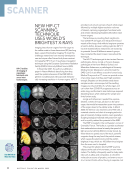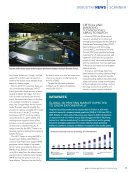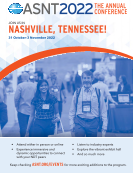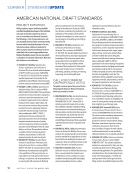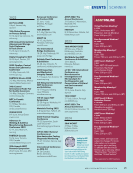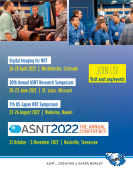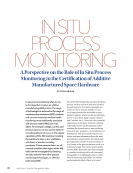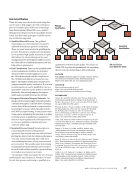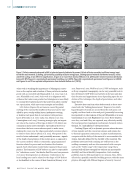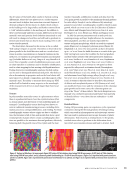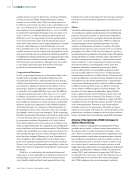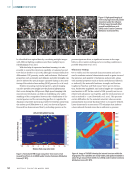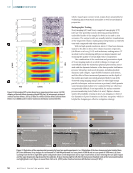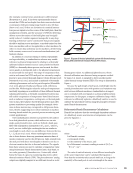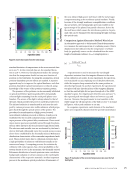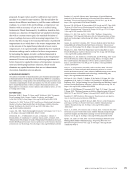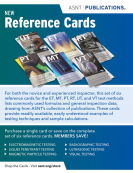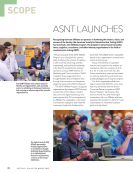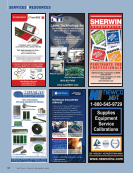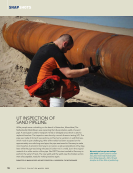APRIL 2022 Volume 80 • Number 4 JOURNAL STAFF PUBLISHER: Neal J. Couture, CAE DIRECTOR OF PUBLICATIONS: Toni Kervina EDITOR: Jill Ross ASSISTANT EDITOR: Cara Markland PRODUCTION MANAGER: Joy Grimm GRAPHIC DESIGNER/ ILLUSTRATOR: Synthia Jester ASNT MEDIA & EVENT SALES Holly Klarman, MCI Group: holly.klarman@wearemci.com 1-410-584-8576 TECHNICAL EDITOR John Z. Chen, KBR ASSOCIATE TECHNICAL EDITORS John C. Aldrin, Computational Tools Sreenivas Alampalli, Stantec Ali Abdul-Aziz, Kent State University Narendra K. Batra, Naval Research Laboratory (retired) Trey Gordon, SpaceX Dietmar Henning, Level III Service LLC Cara A.C. Leckey, NASA Langley Research Center Mani Mina, Iowa State University William E. Mooz, Met-L-Chek Co. Ehsan Dehghan-Niri, New Mexico State University Yi-Cheng (Peter) Pan, Emerson Inc. Anish Poudel, Transportation Technology Center Inc. Donald J. Roth, Roth Technical Consulting LLC Ram P. Samy, Birring NDE Center Inc. Steven M. Shepard, Thermal Wave Imaging Ripi Singh, Inspiring Next Surendra Singh, Honeywell Roderic K. Stanley, NDE Information Consultants Mike C. Tsao, University of Connecticut – Avery Point Lianxiang Yang, Oakland University Reza Zoughi, Iowa State University CONTRIBUTING EDITORS Bruce G. Crouse, Inspection Services Huidong Gao, Pemex Saptarshi Mukherjee, Lawerence Livermore National Laboratory UPFRONT | SCANNER PARADIGM SHIFTS IN ADDITIVE MANUFACTURING Additive manufacturing (AM), synonymous with 3D printing, has revolution- ized manufacturing and reinvigorated various economic sectors (especially aerospace), largely due to its design freedom, reduced costs and lead time, and Industry 4.0 integrations. Despite these successes, business and strategic (supply chain) challenges need to be addressed before it is widely adopted within aviation. Given that 3D-printed aircraft parts are used in systems today, AM industrialization is far from simply “hype.” However, there are issues that require additional attention, including: understanding the complex process physics tuning the materials state concurrently designing parts and materials consistent product integrity and quality assurance universally adopted standards and government approval/ regulations process and data management and supply chain strategy agile scalability limitations building large as well as complex sized titanium and nickel alloy parts limited multi-material capabilities to build a multifunctional part dealing with cybersecurity With respect to the process and materials state, exciting work is ongoing. For example, sophisticated experiments at beam lines are permitting the study of complex dynamics at the micro scale, providing new insights into the AM process. There are efforts to control the materials state (microstruc- ture, texture, residual stress, and defects) through fine-tuning process param- eters and composition, while new integrated models have been developed that promise to accelerate materials development and enable qualification strategies. These support a future of a voxel-by-voxel and part-by-part valida- tion of the material and expected local properties, leading to new qualifica- tion and certification strategies by the appropriate organizations. The promise of tailoring materials state using key process parameters is possible only when we can exploit the AM digital thread and network connectivity. Increasingly, AM systems are designed to connect with Industry 4.0 systems, such as the Internet of Things, cyber-physical systems, and cloud computing. These capabilities enable digital manufacturing systems, yet also present opportunities for cyberattacks. Artificial intelligence (AI) and machine learning (ML) may offer solutions to the inevitable cyberattacks for both the original equipment manufacturer and the supply base. There are exam- ples where a private or public customer has mandated a degree of cyber- security for Industry 4.0 suppliers. While much of AM’s progress today is Edisonian, new hardware and ML could eventually give 3D printers “eyes” (machine vision) and “brains” (closed-looped feedback) to evolve more rapidly. Thus, AM in conjunction with Industry 4.0 presents compelling business opportunities. Through this special issue of Materials Evaluation, we reach out to the industry to embrace the paradigm shift in AM and thereby help the customer supply chain stay ahead of the curve. SURENDRA SINGH FOCUS ISSUE CO-EDITOR HONEYWELL AEROSPACE, SURENDRA.SINGH@HONEY WELL.COM PETER COLLINS FOCUS ISSUE CO-EDITOR IOWA STATE UNIVERSITY, PCOLLINS@IASTATE.EDU A P R I L 2 0 2 2 • M A T E R I A L S E V A L U A T I O N 7
NEW HIP-CT SCANNING TECHNIQUE USES WORLD’S BRIGHTEST X-RAYS Imaging intact human organs from the organ to the cellular scale in three dimensions (3D) has long been a goal of biomedical imaging. To meet this challenge, researchers have recently developed a new technique called hierarchical phase-contrast tomography (HiP-CT), an X-ray phase propagation technique using the European Synchrotron Radiation Facility (ESRF)’s Extremely Brilliant Source (EBS). In November 2021, the authors published a paper in Nature Methods describing how they used the spatial coherence of the ESRF-EBS to perform nondestructive, 3D scans with hierarchi- cally increasing resolution in human organs. HiP-CT provided a structural overview of each whole organ followed by multiple higher-resolution volumes of interest, capturing organotypic functional units and certain individual specialized cells within intact human organs. The technique is providing fresh insights into how COVID-19 damages and reshapes the blood vessels of the lungs. And while its long-term promise is hard to define, because nothing quite like HiP-CT has ever existed before, researchers are excited by its potential. Some 40 different research groups have contacted the team to learn more about the technique. The HiP-CT technique got its start as two German pathologists—Danny Jonigk, a thoracic diseases pathologist at Hannover Medical School, and Maximilian Ackermann, a pathologist at University Medical Center Mainzraced—aimed to track the SARS-CoV-2 virus’s effects across the human body. Medical X-rays such as CT scans can provide a view of an entire organ, but they aren’t high resolution enough. Biopsies can let scientists study tissue samples under a microscope, but the resulting images are only small bits of a whole organ and can’t show how COVID-19 progresses across an entire lung, and the team’s resin technique required dissolving tissue, which destroys the sample and limits further study. Jonigk and Ackermann needed the unprece- dented: a series of X-rays, all done on the same organ, that would let researchers zoom into portions of the organ down to the cellular scale. In March 2020, the German duo reached out to Peter Lee, a materials scientist and chair of emerging technolo- gies at University College London. Lee’s specialty is studying biological materials with powerful X-rays and he quickly realized the potential of the ESRF. The ESRF is located in the northwestern corner of Grenoble, France. The facility is a particle accelerator that makes electrons travel at nearly the speed of light around a half-mile (844 m) circular tunnel. As these electrons speed around the track, powerful magnets along the way bend the particle stream, which causes the electrons to emit the world’s brightest X-rays, which are 100 billion times brighter than the ones used in hospitals. This powerful radiation lets the ESRF examine objects at the scale of micrometers, or even nano- meters. The facility is frequently used to study mate- rials such as alloys and composites, to check the molecular structures of proteins, and even to recon- struct ancient fossils without having to separate rock SCANNER HiP-CT enables 3D imaging of organotypic functional units across intact human organs. Scan QR Code to Watch the Video 8 M A T E R I A L S E V A L U A T I O N • A P R I L 2 0 2 2 CREDIT: REPRINTED WITH PERMISSION UNDER CREATIVE COMMONS LICENSE. C.L. WALSH, P. TAFFOREAU, W.L. WAGNER, ET AL., NATURE METHODS 18, 1532–1541 (2021).
ASNT grants non-exclusive, non-transferable license of this material to . All rights reserved. © ASNT 2025. To report unauthorized use, contact: customersupport@asnt.org











